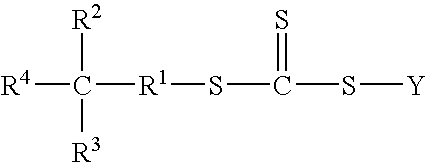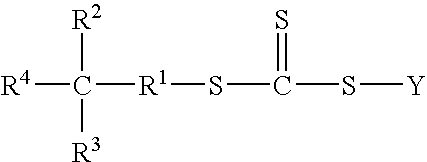Water-based process for the preparation of polymer-clay nanocomposites
a technology of polymer-clay nanocomposites and water-based processes, which is applied in the field of water-based process for the preparation of polymer-clay nanocomposites, can solve the problems of complete disruption of the clay layer structure, and the dispersion state commonly referred to as exfoliation, and achieve the effect of achieving the ultimate state of dispersion
- Summary
- Abstract
- Description
- Claims
- Application Information
AI Technical Summary
Benefits of technology
Problems solved by technology
Method used
Image
Examples
example 1
Preparation of Poly(4-vinylpyridine) By “In-situ” Emulsification Method with Dibenzyltrithiocarbonate (DBTTC) RAFT Agent
[0145]A 500 ml three-necked round bottom flask equipped with a mechanical paddle stirrer, a nitrogen inlet, a pot thermometer, heating mantle and condenser was charged with 1.33 g (˜0.00459 moles) of dibenzyltrithiocarbonate, 60.0 g (˜0.57 moles) of distilled 4-vinylpyridine and 3.6 g (˜0.0127 moles) of oleic acid. The stirred reactor was then purged with a slow bleed of nitrogen before adding an aqueous solution prepared by dissolving 0.36 g (˜0.00133 moles) of potassium persulfate, 0.88 g (˜0.0083 moles) of sodium carbonate, 0.88 g (˜0.010 moles) of sodium bicarbonate and 0.82 g (˜0.0126 moles) of potassium hydroxide in 158 g of reverse osmosis (RO) treated water. A yellow emulsion forms immediately. The emulsion is then rapidly heated to 65° C. and held there with the aid of a thermowatch controller. The progress of the polymerization was followed gravimetricall...
example 2
Preparation of Poly(4-vinylpyridine) By “In-situ” Emulsification Method with S-Benzyl-S′-(2-hydroxydecyl)trithiocarbonate (BHDTTC) RAFT Agent
[0146]Procedure: same as Ex. 1 except that 1.80 g (˜0.00464 moles) of BHDTTC RAFT agent used in place of DBTTC. After a 4 hr. reaction time at 65° C., the reaction was worked up in an identical manner to Ex. 1. 289 g of methanol solution at 19.66 percent solids represents 56.8 g of poly(4-vinylpyridine) or 92 percent conversion.
example 3
Preparation of Poly(4-VP+-b-PS-b-4-VP+) Triblock Copolymer Latex
[0147]50.0 g of 20 percent poly(4-vinylpyridine) methanol solution from Ex. 1 (˜10.0 g of polymer) was placed in a 500 ml single neck flask and stripped of solvent on a rotary evaporator. To the dried polymer was then added 110 g of RO water and 10.0 g of con. hydrochloric acid. The mixture was stirred until a uniform pale yellow aqueous solution was obtained. This solution was then charged into a 500 ml three-necked round bottom flask equipped with a mechanical paddle stirrer, a nitrogen inlet, a pot thermometer, heating mantle and condenser. 0.6 g of potassium persulfate was then added followed by 30.0 g (˜0.288 moles) of styrene. The biphasic stirred mixture was then rapidly heated to 65° C. under nitrogen for 8 hrs. The final latex solids were determined to be 26.7 percent (theory 27.1 percent) or 98.5 percent conversion. A small portion of the final latex was coagulated in dilute potassium hydroxide solution for an...
PUM
| Property | Measurement | Unit |
|---|---|---|
| Temperature | aaaaa | aaaaa |
| Fraction | aaaaa | aaaaa |
| Percent by mass | aaaaa | aaaaa |
Abstract
Description
Claims
Application Information
 Login to View More
Login to View More - R&D
- Intellectual Property
- Life Sciences
- Materials
- Tech Scout
- Unparalleled Data Quality
- Higher Quality Content
- 60% Fewer Hallucinations
Browse by: Latest US Patents, China's latest patents, Technical Efficacy Thesaurus, Application Domain, Technology Topic, Popular Technical Reports.
© 2025 PatSnap. All rights reserved.Legal|Privacy policy|Modern Slavery Act Transparency Statement|Sitemap|About US| Contact US: help@patsnap.com


